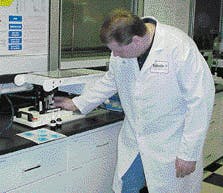Sharper images enhance analysis
Image-processing and display products and technologies are under constant development to obtain highly defined patterns for ever-demanding analysis. For example, medical imaging is seeking to automate the process of inspecting pharmaceutical pump sprays; military imaging is attempting to fuse large 2-D and 3-D data sets into real-time simulations; and all imaging market segments are demanding lower costs for high-resolution liquid-crystal-display (LCD) monitors. In all these applications, OEM and end-user demands for sharper images and superior analysis are spurring the integration of off-the-shelf and customized hardware and software into unique vision/imaging systems.
In medical imaging, there has been no reliable method for characterizing the projected mist pattern of a pharmaceutical nasal spray pump. Now, reports contributing editor Larry Curran, an integrated imaging inspection system has combined application software and vision apparatus to automate pump-spray classification. Moreover, this approach may also help the US Food and Drug Administration to establish an acceptable imaging standard for both vendors and users of medical spraying devices (see p. 25).
Several key challenges in developing military-critical decision-support systems concern the real-time fusion of huge data sets and image sizes from various sources. In deriving the powerful processing capabilities needed to solve these problems, vendors are integrating graphics workstations directly into image servers. As spotlighted by editor Andrew Wilson, these integrated systems are delivering bandwidths from hundreds of megabytes per second to tens of gigabytes per second for 2-D and 3-D mapping, charting, geodesy, and mission-rehearsal imaging applications (see p. 30).
In all imaging applications, LCDs are gaining design wins over their cathode-ray-tube counterparts. In the Product Focus, editor Andrew Wilson details how LCD monitors offer smaller size, lower power consumption, and higher imaging resolution, but at higher prices. However, LCD prices are steadily dropping because of increasing product volumes and video applications and decreasing costs of ownership (see p. 35).
George KotellyEditor in Chief[email protected]

